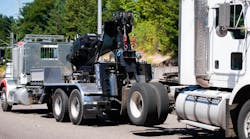If the Teamsters try to repeat their UPS victory by striking LTLs, more union jobs will be lost
The UPS strike appears to have increased traffic for LTL carriers in August by over 20% from July levels. Most of this increase was small packages of course, and this business wasn't kept permanently by the LTL carriers after UPS resumed full service.
Even though most of the overflow business wasn't retained, LTL carriers demonstrated that they were better equipped to handle the extra business than they were during the strike three years ago. Over the past few years, carriers in general have become a little more flexible in their operations, better able to open and close terminals, increase business, and adapt more quickly.
These changes have profound consequences for the current negotiations between the unionized LTL carriers and the Teamsters union. During the last LTL strike, although a few carriers permanently retained some of the overflow business, most handled more freight only temporarily. Carriers bit off more than they could chew, resulting in serious operational indigestion.
Don't look for that scenario next year if there is a strike. The non-union carriers will have had four years of growth and preparation for further growth. They will have had four years to identify which freight is most profitable for their operations. The competitive markets over the last four years will have made them leaner and better able to see where they're going and which shippers are going to take them there. In short, the non-union carriers are in a position to handle a large chunk of the freight during an extended strike, and they will keep it.
Shippers have already begun to ask non-union carriers whether they will have capacity next year to accommodate them. Their reply is: "Don't come to us in April. You need to establish a relationship with us today, at a minimum level. You need to be a customer today if you want protection in April 1998." The impending strike is allowing the non-union carriers to unabashedly cherry-pick the best shippers and the most profitable freight.
Economically, a strike makes little sense because it will permanently hurt both labor and management. Although 1997 will show good year-over-year financial results for union carriers, the profit margin over the last five years makes a poor argument for large wage increases. If the management/ labor negotiations follow their usual pattern -- which would culminate in a strike for a few weeks, followed by a settlement that includes higher wages and more restrictive work rules -- the erosion of union jobs will continue.
Politically, a strike is more important for the union. The current controversies over fundraising, new elections, and general drift in union leadership make it more important for union leaders to make another `score' like the UPS strike. Instead of focusing on long-term issues, such as driver training and the erosion of union jobs, the Teamsters are driven to protect the jobs and wages of their current members, regardless of the negative effects on future union members.
The central irony here is that the "Big 4" union carriers have done an incredible job of remaining competitive in today's market, and even growing (although losing market share) while carrying the burden of a 25% premium on labor compensation. At present, wages and fringe benefits account for a little more than half of LTL expenses. With a labor premium of about 25%, LTL carriers are going to their customers with at least a 12% cost disadvantage compared to non-union carriers. In addition, union carriers have more restrictive labor guidelines that, for better or worse, increase their operating costs. The "Big 4" must be doing many things right to stay alive in this fiercely competitive environment, given that kind of labor-cost disadvantage.
It's not news, but it bears repeating: The underlying conflict is not a dispute between union labor and management. It's between union carriers and lower-cost non-union carriers. Unless union and management can find some common ground before April, there will be a lot less ground to stand on for either side.


